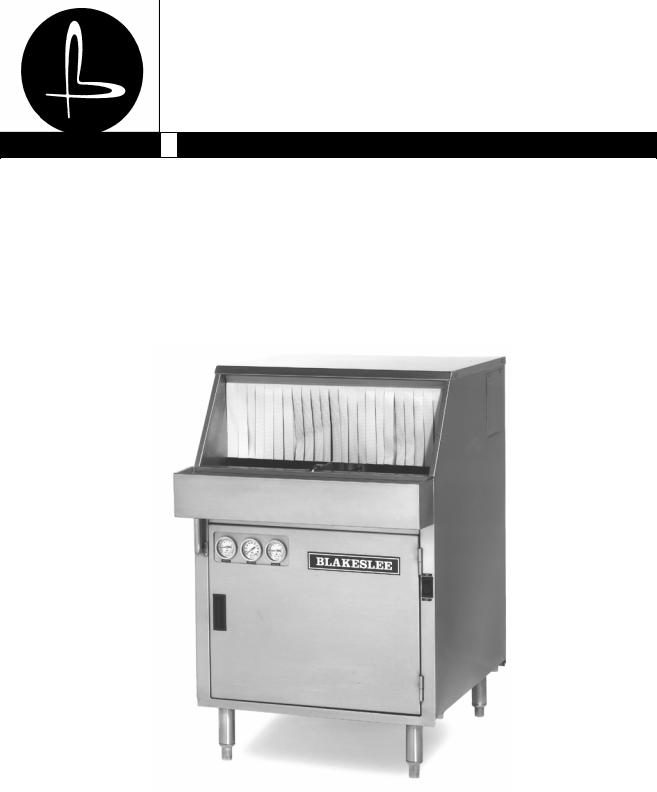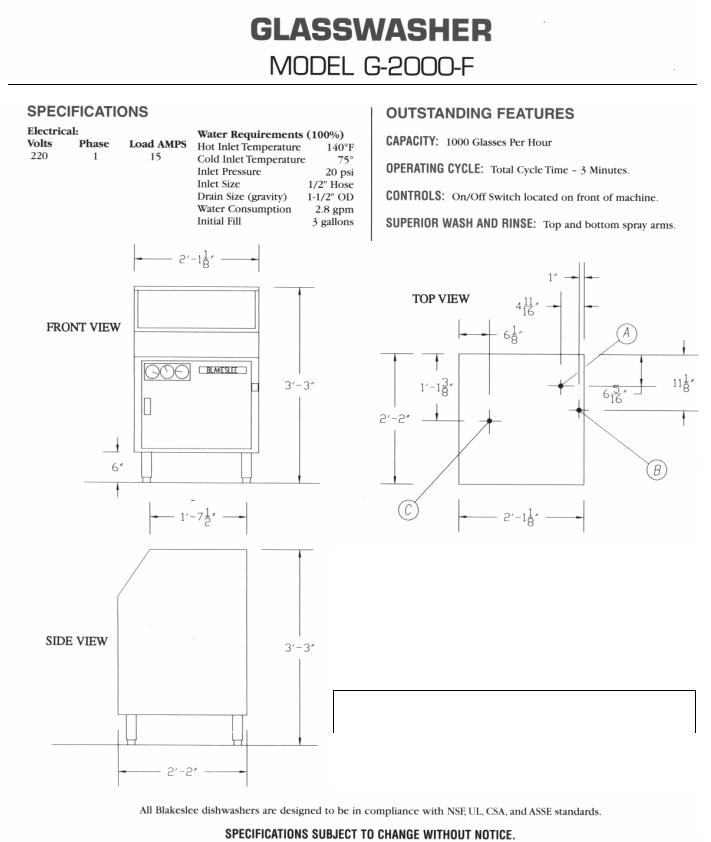Blakeslee G-2000-F Operators Manual

OWNERS
MANUAL
BLAKESLEE 

 Division of Blako Inc.
Division of Blako Inc.
GLASSWASHER
MODEL G-2000-F
1844 South Laramie Avenue |
www.blakesleeinc.com |
1149 Bellamy Road North Unit 19 |
Chicago, IL 60804 |
|
Scarborough, Ontario Canada M1H1H7 |
Phone (708) 656-0660 |
service@blakesleeinc.com |
Phone (416) 751-2625 |
Fax (708) 656-0017 |
|
Fax (416) 751-8539 |

INDEX
|
PAGE |
|
NO. |
SPECIFICATIONS |
1 |
SECTION I OPERATION |
2 |
SECTION II DAILY CHECK-OUT |
3 |
SECTION III CLEANING |
4 |
SECTION IV TROUBLE SHOOTING |
5 |
SECTION V PARTS ILLUSTRATIONS |
7 |
WIRING DIAGRAM |
16 |
CLEANING TOOL |
18 |
WARRANTY |
19 |

(A)HOT WATER CONNECTION (1/2” N.P.T. FEMALE FITTING)
(B)COLD WATER CONNECTION (1/2” N.P.T. FEMALE FITTING)
(C)1-1/2” O.D. DRAIN
NOTE: If your water pressure is over 25 psi; installation of a pressure reducing valve is necessary.
It is recommended that check valves be installed in both incoming water supplies.
APPROXIMATE SHIPPING INFORMATION
MODEL |
DIMENSIONS |
WEIGHT |
CUBE |
G-2000-F |
47” xX27” X 28.5 |
160 lbs. |
21.0 Ft. |
1

SECTION I OPERATION
1-1 Water
The wash tank is equipped with a float assembly that turns water off when proper level is achieved.
The water temperature is controlled by a heater and a thermostat. The thermostat should be set to provide a wash water temperature between 145° F /60° C and 160° F /71° C.
1-2 Filling Wash Tank
Ensure that the standpipe is in place. Put the toggle switch in the “AUTO” position. This will also turn the heater on. To start the conveyor and detergent pump, put the main switch on the front of the machine in the” ON” position.
Detergent is fed from the supply container into the detergent tank in controlled amounts by the detergent pump. Use detergent at strength of 0.35% or as recommended by your chemical supplier to accomplish the necessary cleaning job.
NOTE: Use a heavy-duty NON-CHLORINATED liquid detergent manufactured specifically for glassware washing machines.
Your chemical representative will test the solution to insure the proper strength is recommended.
NOTE: Many of the detergents used in glass and dishwashers are harmful to the skin in their concentrated form. To prevent accidental exposure to this danger, be sure all hoses are secure and clamped after service to machine.
1-3 Chemical Settings
Approximate chemical settings can be obtained by counting the revolutions of the injector rotors.
For detergent, one revolution per second equals approximately .035% concentration.
For sanitizer, one revolution in 5 seconds equals approximately .035% concentration
For rinse agent, on revolution in 8 seconds is suggested.
1-4 Detergent Injector Adjustment
1. Install the detergent tank standpipe and switch tank fill toggle switch to “AUTO” position. The detergent feeder will now feed detergent into the detergent tank with water fill.
2.To increase detergent volume, turn the detergent adjustment screw clockwise.
3.To decrease detergent volume, turn the detergent adjustment screw counter-clockwise.
1-4 Sanitizer Injector Adjustment
The sanitizer is automatically fed into the line through the sanitizer injector. Injection is into the final rinse sprays.
1.When a new sanitizer container is installed, push the prime button in and hold until sanitizer feed tubes are full.
2.Start the washer—take a sample from the final rinse spray tubes.
3.To increase sanitizer volume, turn the detergent adjustment screw clockwise.
4.To decrease sanitizer volume, turn the detergent adjustment screw counter-clockwise.
NOTE: If iodophor is being used as a sanitizer, it is not necessary to use a separate rinse agent. To turn the rinse agent injector “OFF” in this case, turn the adjustment screw counter-clockwise until the rotor stops turning.
NOTE: If chlorine is being used, a separate rinse agent is required to prevent spotting.
1-5 Rinse Agent Injector Adjustment
1.When a new rinse agent container is installed, push the prime button in and hold until sanitizer feed tubes are full.
2.Start the washer—take a sample from the final rinse spray tubes.
3.To increase rinse agent volume, turn the detergent adjustment screw clockwise.
4.To decrease rinse agent volume, turn the detergent adjustment screw counter-clockwise.
NOTE: The above only allows for testing the sanitizer being fed. Actual sanitizing rinse solution should be tested by your chemical supplier representative.
NOTE: To meet the requirement of N.S.F. standards, iodophor in a concentration of 12.5 p.p.m. of chlorine at 50 p.p.m. must be used in the final rinse.
2

SECTION II DAILY CHECK-OUT
1.Clean machine. (See cleaning instructions on next page.)
2.Drain deflector is in position in drain.
3.Splash curtain is in position.
4.Right and left-hand trays are in position
5.Wash return screen for wash water is clean and in place.
6.Standpipe in the detergent tank is in place.
7.Bottom drain screen is in position.
8.Ensure that the mixing valve is adjusted.
9.Place the fill valve switch in “AUTO” position.
10.Wait for the detergent tank to reach the desired temperature. (145° F /60° C and 160° F /71° C.)
11.Check the detergent, sanitizer, and rinse agent supply.
12.Switch the Glasswasher on.
3

SECTION III CLEANING
Daily Cleaning Instructions:
1.Run glassware through the machine, and then clear the conveyor of glassware.
2.Turn the machine off.
3.Remove right and left-hand trays and splash curtain. Wash with hot soapy water, rinse thoroughly, and then dry.
4.Remove the conveyor as follows:
•Remove sleeve in center of conveyor.
•Lift back of conveyor until it is free of drive gear.
•Raise front of conveyor and remove from wash section.
5.Remove drain deflector screens. Clean, wash and rinse areas with hot soapy water, rinse thoroughly, then dry.
6.Replace drain deflector screens, conveyor, right and left-hand trays, and splash curtain. Ensure conveyor is level and engaged with drive gear.
7.Turn auto fill switch to “OFF” position.
8.Remove wash return screen from below detergent tank. Clean and replace.
9.Turn fill switch to “AUTO” position.
10.Ensure there is product in the detergent, sanitizer, and rinse agent containers.
11.Check the detergent, sanitizer and rinse agent feed lines to ensure they are in place and securely clamped.
4

SECTION IV TROUBLE SHOOTING
Trouble shooting procedures are listed in the following table. Each trouble is followed by a list of possible causes and suggested procedures to correct the cause.
In general, the procedures should be performed in the order in which they are listed.
Trouble |
Possible Cause |
Corrective Procedure |
|
|
|
|
|
1. Conveyor does |
not turn |
|
|
|
No power |
Check the fuse on panel. |
|
|
Drive motor burnt out |
Replace motor |
|
|
Obstruction in wash or rinse section |
Remove the obstruction |
|
|
Table limit switch not making contact or faulty |
Adjust micro-switch or replace if faulty |
|
|
Conveyor not in position |
Position properly |
|
|
|
|
|
2. Overspray from |
hood section |
|
|
|
Splash curtain not in position |
Reinstall splash curtain |
|
|
Washer running without any glasses on |
Load conveyor with glasses |
|
|
conveyor |
Clean thoroughly, use jet reamer provided |
|
|
Spray boxes plugged |
||
3. Chemical containers filling with water |
|
|
|
|
Dirty rinse spray box |
Refer to cleaning section |
|
|
Element tube stretched; pinhole in tubing; |
Replace tubing |
|
|
loose hose ties |
Replace flow washer |
|
|
Worn flow washer in solenoid valve |
||
|
|
|
|
4. Lack of pressure |
at wash spray tubes |
|
|
|
No water in detergent tank |
a. Make sure stand pipe is in place in tank |
|
|
|
|
b. Check that the fill switch is in “AUTO” |
|
|
|
position and that tank fills |
|
|
|
c. Make sure that the float switch is operating |
|
|
|
d. Check that the fill solenoid is operating |
|
Pump not operating |
a. Check power supply to machine |
|
|
|
|
b. Check pump capacitor, replace if |
|
|
|
necessary |
|
|
|
c. Replace pump if necessary |
|
Pump defective |
a. Replace pump impeller if not working |
|
|
|
|
correctly |
|
|
|
b. Check for voltage drop |
|
Wash spray box dirty |
Clean thoroughly, use jet reamer provided |
|
|
Supply line plugged |
Clear line of cause |
|
|
|
|
|
5. Lack of pressure |
in spray boxes |
|
|
|
Shut-off valve on supply line closed |
Open valve |
|
|
Low water pressure |
Have pressure taken on main cold water line |
|
|
|
|
to machine. Pressure must be 25 p.s.i. |
|
Rinse solenoid will not operate |
Replace coil if necessary |
|
|
Rinse solenoid strainer plugged |
Clean or replace |
|
|
Spray boxes plugged |
Clean thoroughly, use jet reamer provided |
|
|
Supply line plugged |
Clear line of cause |
|
|
|
|
|
6. Continual flow of water through detergent tank or spray boxes with machine off |
|||
|
Solenoid valve not seating |
|
a. Turn off water supply |
|
|
|
b. Take apart and clean thoroughly |
|
|
|
c. If above does not cure, replace plunger |
|
|
|
and seat |
|
|
|
|
5
